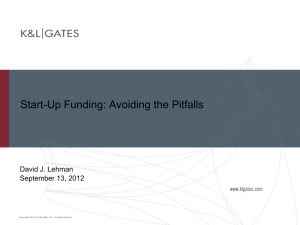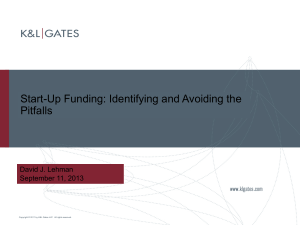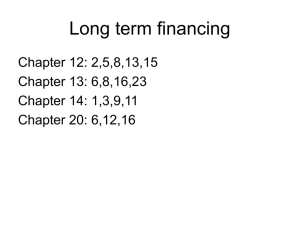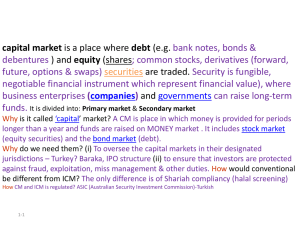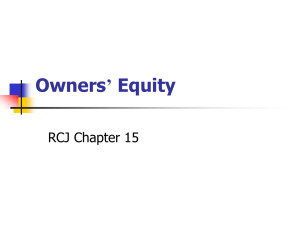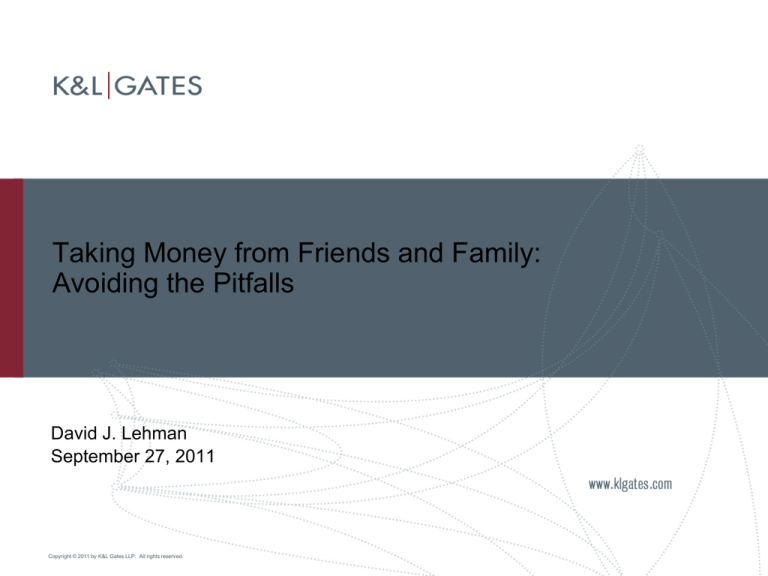
Taking Money from Friends and Family:
Avoiding the Pitfalls
David J. Lehman
September 27, 2011
Copyright © 2011 by K&L Gates LLP. All rights reserved.
Agenda
Introduction
Applicable Laws
The Security
Commonly Discussed Terms
Top 10 (or so) Pitfalls
Questions and Answers
1
Funding Cycle
Incubators (e.g., Project Olympus, Idea Foundry, Alpha Lab)
Public or quasi-public funds (e.g., Innovation Works, Pittsburgh
Life Sciences Greenhouse, Technology Collaborative)
Friends and Family
Angels
Early Stage
Later Stage
Venture Capital
Early Stage
Later Stage
Public Markets
2
Alternative Sources of Capital
Customers
Public financing/grants/loans
Debt
Bootstrapping
3
Applicable Laws
Securities Act of 1933
Securities:
“Any note, stock, bond, debenture, evidence of
indebtedness…investment contract…”
Excludes short term note (typically less than 9 months)
Securities Act – Registration
In general: Registration is required with the Securities and
Exchange Commission for the sale of securities (e.g., an S-1)
Registration is expensive and time-consuming
Objective: Avoid registration
4
Exemptions from Registration
Section 3(b) – Small Offering
Section 4(2) – Private Offering
Effect of Exemption
Exemption from Registration Process
No Exemption from:
Notice Filing
Fraud provisions of the Securities Act
5
Safe Harbor: Regulation D
Rule 506 (under Section 4(2)):
Unlimited number of Accredited Investors
Up to 35 Persons who are not Accredited Investors
For Unaccredited Investors, detailed information
must be provided
Rule 504 (under Section 3(b)):
The aggregate offering price can not exceed
$1,000,000
6
Accredited Investors
Natural person who, together with spouse, has a net
worth of more than $1,000,000 (excluding residence);
or
Natural person with individual income of at least
$200,000 (or joint income with spouse of $300,000)
in each of the two most recent years and has a
reasonable expectation of the same income in the
current year; or
Corporation or partnership not formed for the specific
purpose of investing with assets in excess of
$5,000,000; or
Any director, executive officer or general partner of
the issuer
7
Common Requirements for Regulation D
Exemption:
No general solicitation or general advertising
(advertisement, article or media broadcast (hint: no
website ads))
Reasonable belief that the purchaser is purchasing
for purposes of investment and not resale (hint: get a
representation)
File a Form D (no later than 15 days after the first
sale)
8
Blue Sky Laws (State Requirements)
State-by-state regulation
National Securities Markets Improvements Act of
1996
Preempts state regulation
4(2) exemption – Rule 506
Not Rule 504
Still requires notice and filing fees (concession to
states)
Check states – Example: NY
9
Bottom Line
Rely on 506 and limit to Accredited Investors; or
Rely on 504 (under $1,000,000) and find state
exemption
10
Disclosure
Requirements
Private Placement Memorandum
Protection for “fraud” claims under Securities Act
Material misrepresentation
Omit to state a material fact necessary to make the
statements made not misleading
Professionalism
11
Key Elements of Private Placement
Memorandum
Description of Issuer
Business Plan
Risk factors
Subscription procedures
Conflicts of interest
Financial Statement
Capitalization
Exhibits (e.g., organizational documents)
In general – “Material” information
12
Reason for Compliance
Purchaser remedies – rescission
Future potential investors
Insurance Policy
13
Type of Security
Debt
Common Equity
Preferred Equity
Convertible Debt
14
Debt
Benefits
Simple
Downside
Must be paid
Interest
Must pay
Tax Implications
Balance Sheet Implications
No upside for investor
15
Common Equity
Benefits
Simple
Aligns Interests
Downside
Valuation
Likely lower price (see example)
16
(Light) Preferred
Description
Liquidation Preference
Dividend
Participating v. non-participating
Fewer control features than typical preferred
Benefits
Attracts investors
Downside
Complexity
Separate class of stock (hidden rights)
Potential impact on future investors
Valuation
17
Convertible Debt
Description
Convertible to equity upon trigger events
Sometimes convertible into new security
Sometimes convertible into common stock
Discount to investment price (e.g., 20%)
Fancy conversion terms (avoid)
Base price in case of no additional investment
Benefits
Common
Avoids the “valuation issue” (sort of…)
Downside
Conversion price unknown
Usually accrues interest (additional dilution)
Debt holders can have interests that are not aligned with
common
18
Factors In Valuation
Availability of capital
Amount of raise and dilution
Type of investors
Anticipated growth from investment
Future plans for financing
19
Valuation
Hard to value at this point
Alpha Lab - $25,000 for 5% common ($500,000
post-money valuation)
Caution of giving up over 10% of the Company
for an angel round (so, if you are raising
$100,000, post money of $1M)
20
Example 1
(Priced Round)
Initial
Founder
Shares
1,000,000
Percentage
Ownership
100%
21
Example 1
Employee Equity
Founder
Employees
Total
Shares
1,000,000
176,471
1,176,471
Percentage
85%
15%
100%
22
Example 1
Friends and Family Round
(Priced Round)
$250,000 Friends and Family
$1,250,000 Post-Money Valuation
Founder
1,000,000
Employees
176,471
F&F
294,118
Total
1,470,589
68%
12%
20%
100%
23
Example 1
Series A Round
$2M Investment
$5M Post-Money Valuation
Founder
Employees
F&F
VC
Total
1,000,000
176,471
294,118
979,608
2,450,197
41%
7%
12%
40%
100%
Note: VC will want Employees’ amount increased
Note Control
24
Example 2
Initial
Founder
Employees
Total
Shares
1,000,000
176,401
1,176,471
Percentage
85%
15%
100%
25
Example 2
(Convertible Debt)
$250,000 Friends and Family; convertible debt-20%
discount
Series A – $2M investment at $5M post-money
valuation
Founder
Employees
F&F
Series A
Total
1,000,000
176,401
136,791
875,461
2,188,653
46%
8%
6%
40%
100%
26
Comparison of
Priced Round v. Convertible Debt
Founder
Employees
F&F
Series A
Total
Example 1
(Priced Round)
Example 2
(Convertible Debt)
41%
7%
12%
40%
100%
46%
8%
6%
40%
100%
27
Example 3
Too Much Convertible Debt
$1,000,000 Friends and Family; convertible debt
(20% discount)
Series A – $2M investment at $5M post-money
valuation
Founder
Employees
F&F
Series A
Total
1,000,000
176,401
840,286
1,344,458
3,361,145
30%
5%
25%
40%
100%
28
Comparison
Example 1
Example 2
($250,000
($250,000
Priced Round) Convertible
Debt)
Founder
Employees
F&F
Series A
Total
41%
7%
12%
40%
100%
46%
8%
6%
40%
100%
Example 3
($1M Convertible
Debt)
30%
5%
25%
40%
100%
29
Commonly Discussed Terms
Maintenance Rights
End it
Require that they continue to be Accredited
Investors
Quick Resolution
Waivable
Proper exclusions (including requirement of new
investor or strategic investor)
30
Commonly Discussed Terms
Control/Management
Board Representation
Board seat
Board control
Observer
31
Commonly Discussed Terms
Approval Rights (Board or investor)
Day-to-day
Fundamental transactions (sale of the company)
Future financings
Employee equity
32
Commonly Discussed Terms
Shareholder Arrangements
Agreement to execute a Shareholder Agreement
(for note holders)
Drag-Along rights
Restrictions on transfer of stock
33
Commonly Discussed Terms
Information Rights
Subordination (Debt)
Anti-Dilution Protection
34
Bottom Line
Common or Convertible Debt
Minimize the angel funding – it is likely to be
expensive money
Minimize control of investor
Keep it simple
35
Top Ten (or so) Mistakes
Over-Promise – Under – Deliver
Disrespect Capital
Target Old Ladies, Pensions and Thanksgiving
dinner companions
Poison the Company and make it unattractive to
Future Investors
Not enough capital for management
Give away rights of first refusal or exclusivity
Severely underestimate the cost and time
Leave the numbers to somebody else
Waste resources
Give up control (legally or mentally)
36
Forget that you don’t know what you don’t know
Over-capitalize or over-leverage
Ignore securities laws (general solicitation, filing)
Don’t align interests
Engage an estate planning lawyer
37
Questions and Answers
38

